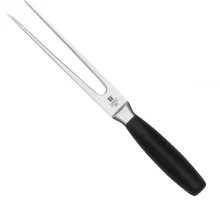Project Report For Carving Fork
Introduction
Project report for Carving Fork is as follows.
A kitchen tool made exclusively for carving meat is a carving fork. It is utilised along with a carving knife, a highly sharp knife that rapidly and cleanly slices through meats like roasts. A carving fork is still an essential tool whether carving takes place at the table or in the kitchen since it secures the meat, making it simpler and less messy to cut. These forks are available in most kitchen supply stores, and they can also be acquired in bulk from businesses that focus on kitchen products.
A typical tool for use for slicing meats, poultry, fish, and other foods. When food is being prepared, carving forks are used to hold food firmly in place and keep hands away from the knives’ sharp blades. Longer tines will allow the fork to dig deeper into the food, keeping larger chunks of meat stable while they are being cut.
Although a carving fork and a table fork resemble each other somewhat, there are some important distinctions. The first is size; a carving fork is far larger than a regular fork since it is made to easily cut through enormous roasts. Additionally, the fork only has two tines and a long handle, keeping the chef’s hand away from the meat and the carving knife. A carving fork and knife might occasionally be marketed together as a pair, complete with matching handles.

Types Of Carving Fork
- Straight Carving Fork: The carving fork with two straight, pointed tines is the most typical. Larger chunks of meat, like roasts and turkeys, fit perfectly inside.
- Curved Carving Fork: The curved form of this kind of fork aids in guiding the carving knife as you cut into the meat. When carving bone-in cuts of meat like gammon or prime rib, it is especially helpful.
- Two-Pronged Carving Fork: The only tines on this kind of fork are two, as the name would imply. Smaller slices of meat, like chicken or pork tenderloin, are frequently used with it.
- Electric Carving Fork: This particular carving fork was created to be used with an electric knife. It contains a set of teeth that are serrated, which makes it easier to grab the meat and hold it firmly in place during carving.
- Long Carving Fork: This kind of fork is perfect for holding larger chunks of meat, such entire pigs or beef brisket, because its tines are longer than those of a typical carving fork.
- Short Carving Fork: This kind of carving fork has shorter tines than a standard carving fork, making it easier to wield while carving thinner slices of meat, like boneless chicken breasts.
Get Completely Custom Bankable Project Report
Market Potential Of Carving Fork
The market for carving forks is anticipated to reach an estimated value of USD 789.95 million by 2028 and expand at a CAGR of 8.40% from 2021 to 2028.
There are many ways to examine the market potential for carving forks, including the rising popularity of home cooking and entertaining, the rising need for high-quality kitchenware, and the possibility for innovation and market distinction.
Market growth is influenced by a variety of variables, including expanding urbanisation, rising disposable incomes, and shifting consumer tastes. As people spend more time at home, they are making investments in their kitchens and culinary equipment. The size of the carving forks market in India is probably going to increase as a result of this trend.
Additionally, the expansion of e-commerce in India has eased consumers’ access to a wider range of goods, including carving forks. A variety of kitchenware products, including carving forks, are available at affordable costs on online marketplaces like Amazon, Flipkart, and BigBasket. Customers now find it simpler to compare prices and buy goods that are tailored to their needs.
The expanding acceptance of Western-style cooking is another factor that is anticipated to influence the size of the carving fork market in India. Indians are expected to look for specialised kitchenware like carving forks as more of them experiment with cooking other cuisines. Additionally, as consumers become more health-conscious, they are choosing leaner meat cuts that necessitate more exact carving, which increases the demand for carving forks.

